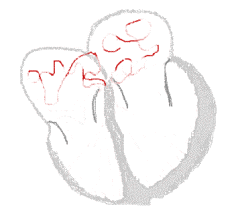Supraventricular tachycardia

Editor-In-Chief: Prab R Tumpati, MD
Obesity, Sleep & Internal medicine
Founder, WikiMD Wellnesspedia &
W8MD medical weight loss NYC and sleep center NYC
| Supraventricular tachycardia | |
|---|---|
| Synonyms | SVT, paroxysmal supraventricular tachycardia (PSVT) |
| Pronounce | N/A |
| Specialty | N/A |
| Symptoms | Palpitations, dizziness, shortness of breath, chest pain |
| Complications | Heart failure, syncope |
| Onset | Sudden |
| Duration | Minutes to hours |
| Types | N/A |
| Causes | Re-entry circuit, accessory pathway |
| Risks | Caffeine, alcohol, stress, smoking |
| Diagnosis | Electrocardiogram (ECG), Holter monitor |
| Differential diagnosis | Atrial fibrillation, ventricular tachycardia |
| Prevention | N/A |
| Treatment | Vagal maneuvers, medications, catheter ablation |
| Medication | Beta blockers, calcium channel blockers, adenosine |
| Prognosis | N/A |
| Frequency | 2.25 per 1000 people per year |
| Deaths | Rare |





Supraventricular tachycardia (SVT) represents a group of arrhythmias, or irregular heart rhythms, characterized by a heart rate exceeding the typical range and originating from cardiac tissue above the level of the ventricles. This means the abnormal rhythm arises either from the atria or the atrioventricular (AV) node.
Etiology and Pathophysiology[edit]
SVT typically results from faulty electrical activity in the heart. While several factors may contribute to its development, SVT commonly stems from a reentrant pathway, where the electrical impulses circularly move through the heart's conduction system, or an ectopic pacemaker, where a site other than the sinus node initiates the electrical signal.
Clinical Presentation[edit]
Symptoms of SVT can vary, ranging from almost unnoticed to debilitating. Common symptoms include palpitations, shortness of breath, chest discomfort, and light-headedness. In extreme cases, it can lead to unconsciousness or cardiac arrest, though this is rare.
Diagnosis[edit]
The primary tool for diagnosing SVT is an electrocardiogram (ECG), which records the electrical activity of the heart. In SVT, the ECG typically shows a rapid heart rate and narrow QRS complexes, but aberrant conduction or preexcitation may sometimes be present. Additional diagnostic tools can include Holter monitoring, exercise stress testing, and electrophysiological study.
Treatment and Management[edit]
The management of SVT aims at controlling the heart rate, preventing recurrences, and managing potential complications. Initial treatment options can include vagal maneuvers or medications that slow the heart rate such as beta-blockers or calcium channel blockers. In cases where these approaches are ineffective or if the patient has recurrent episodes, catheter ablation may be considered. This procedure targets and destroys the abnormal electrical pathways causing SVT.
See Also[edit]
References[edit]
<references group="" responsive="1"></references>
Ad. Transform your life with W8MD's Budget GLP-1 injections from $75


W8MD offers a medical weight loss program to lose weight in Philadelphia. Our physician-supervised medical weight loss provides:
- Weight loss injections in NYC (generic and brand names):
- Zepbound / Mounjaro, Wegovy / Ozempic, Saxenda
- Most insurances accepted or discounted self-pay rates. We will obtain insurance prior authorizations if needed.
- Generic GLP1 weight loss injections from $75 for the starting dose.
- Also offer prescription weight loss medications including Phentermine, Qsymia, Diethylpropion, Contrave etc.
NYC weight loss doctor appointmentsNYC weight loss doctor appointments
Start your NYC weight loss journey today at our NYC medical weight loss and Philadelphia medical weight loss clinics.
- Call 718-946-5500 to lose weight in NYC or for medical weight loss in Philadelphia 215-676-2334.
- Tags:NYC medical weight loss, Philadelphia lose weight Zepbound NYC, Budget GLP1 weight loss injections, Wegovy Philadelphia, Wegovy NYC, Philadelphia medical weight loss, Brookly weight loss and Wegovy NYC
|
WikiMD's Wellness Encyclopedia |
| Let Food Be Thy Medicine Medicine Thy Food - Hippocrates |
Medical Disclaimer: WikiMD is not a substitute for professional medical advice. The information on WikiMD is provided as an information resource only, may be incorrect, outdated or misleading, and is not to be used or relied on for any diagnostic or treatment purposes. Please consult your health care provider before making any healthcare decisions or for guidance about a specific medical condition. WikiMD expressly disclaims responsibility, and shall have no liability, for any damages, loss, injury, or liability whatsoever suffered as a result of your reliance on the information contained in this site. By visiting this site you agree to the foregoing terms and conditions, which may from time to time be changed or supplemented by WikiMD. If you do not agree to the foregoing terms and conditions, you should not enter or use this site. See full disclaimer.
Credits:Most images are courtesy of Wikimedia commons, and templates, categories Wikipedia, licensed under CC BY SA or similar.
Translate this page: - East Asian
中文,
日本,
한국어,
South Asian
हिन्दी,
தமிழ்,
తెలుగు,
Urdu,
ಕನ್ನಡ,
Southeast Asian
Indonesian,
Vietnamese,
Thai,
မြန်မာဘာသာ,
বাংলা
European
español,
Deutsch,
français,
Greek,
português do Brasil,
polski,
română,
русский,
Nederlands,
norsk,
svenska,
suomi,
Italian
Middle Eastern & African
عربى,
Turkish,
Persian,
Hebrew,
Afrikaans,
isiZulu,
Kiswahili,
Other
Bulgarian,
Hungarian,
Czech,
Swedish,
മലയാളം,
मराठी,
ਪੰਜਾਬੀ,
ગુજરાતી,
Portuguese,
Ukrainian


